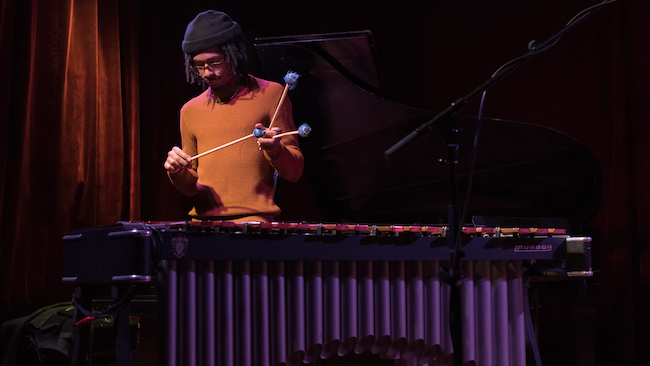Joel Ross’s first album, KingMaker, was released in 2019 on Blue Note, the revered jazz label. He’s worked with his own Good Vibes band and, among others, with trumpeter Marquis Hill, drummer Makaya McCraven, and pianist James Francies.

The New York Times called the 25-year-old a "bright young vibraphonist on his own rocket-like trajectory," and here he takes us on a tour around his instrument.
Mechanics
A vibraphone might look like a kind of large xylophone, but it’s much more sophisticated than that. Vibraphonists know their instrument is in the percussion family, Joel explains. "Meaning you hit it," he says with a smile. "We use mallets to produce sounds, hitting aluminum bars that resonate and produce a tone."
Using harder or softer mallets produces different tones, but what makes the vibraphone unique, Joel says, is its vibrato. "It’s called the vibraphone because it has a motor that drives pulsator discs, or fans, that spin at the top of the resonator tubes under the bars, and when you use the motor it gives the vibraphone a vibrato, that distinctive woo-woo-woo-woo-woo sound.
You can usually vary the speed of the vibrato, too. Also, it’s the only mallet instrument where none of the bars are raised—they’re all on the same level. The resonators have to be on the same level, whereas with marimbas and so on, the rear set of bars equivalent to the piano’s black keys are raised."
The presence of the motor leads some to conclude that it’s an electric instrument, but in its pure form it’s decidedly acoustic. The vibraphone also has a damper foot-pedal. "When you release the pedal, similar to a piano, it lets the notes ring out," Joel says, "and you can hear the vibrato in the notes." Undamped like that, a vibraphone is capable of a very long sustain indeed—around a minute or so, he reports.
The vibraphone has changed very little since it first appeared around a hundred years ago in the early decades of the 20th century.
"There isn’t much to be done, besides changing things aesthetically. There’s a company called Malletech in New Jersey who do something different with the resonators. Normally, the discs spin 180 degrees, like regular fans, whereas Malletech have ‘wings’ that lay flat and go side to side, which gives a sort of cleaner effect for the resonators. I’m not sure how much of that gets to the audience, but for vibraphonists it does give a cleaner effect for playing."
Hitting the Thing
How many mallets? It’s a question for the individual player, but Joel prefers two or three. "That way I treat it like a single-line instrument, similar to a horn player. That came from when I was starting and listening to a lot of Milt Jackson, Lionel Hampton, Red Norvo. But you’ll see a lot of four-mallet playing, which Gary Burton made extremely popular, when the vibraphone is used as a comping instrument."
In jazz, "comping"means chordal accompaniment or support for a soloing instrument. "With more mallets," he continues, "you have the ability to form chords, which makes a nice change in texture and timbre from a guitar or a piano. Using four mallets, say, you have four notes to work with, which leaves a lot of space for an instrumentalist. I personally take that even further—I prefer only three or two to comp, to leave even more space for an improviser to fill. I don’t feel like four mallets are necessary all the time, with a whole band going."
Most vibraphones offer three octaves to work with, from F to F, laid out just like a keyboard, with the "white" notes in front of you and the "black" notes in the row behind. Joel mentions that some makers, including Yamaha, have added extra lower notes to increase the range. "Once you get down there, though, you can hear more of the overtones, which might get in the way of the actual notes we’re trying to play. I would personally like to see a vibraphone that goes up into some higher notes, higher than the normal F that we get."
The instrument’s marriage of percussion and harmony is at the core of its appeal, and for a jazz musician like Joel, much of the challenge is to balance percussion technique with melodic and harmonic invention:
"We have to develop proper technique percussion-wise, so that you’re not harming yourself and you’re producing as good a tone as possible. Especially in jazz and improvisation, there’s a lot that you can get into harmonically and theoretically. So I focus technique-wise to produce the best sound and the best tone—but a lot of my thinking and a lot of my practicing actually happens at the piano, because the information translates so easily."
Joel might have been a drummer. Born in Chicago, he and his twin brother started very young playing the drums, two or three years old, later joining their elementary school’s concert band. One had to play drums and the other the mallet instruments, and that marked his introduction to the vibraphone and timpani.

"That same year, we auditioned on drums for the All-City concert band, and my brother got in on drums. They suggested that I play the vibraphone as I was already playing mallets in the concert band. I didn’t want to do that initially, but the teacher and my dad said I should. So, reluctantly, I did that for a while." He adds, with a laugh: "And I’ve kind of stuck with it ever since."
Vibraphonists do tend to come to the instrument from drums. "I rarely hear about a vibraphonist starting only on the vibraphone," he says. "Because it’s so related to all other percussion instruments, it makes sense to have some kind of knowledge from dealing with the other percussion instruments. I think the difference is how you get to playing jazz on the instrument—the majority of vibraphonists come from a classical background. But, you know, vibraphonists tend to stick together. We’re always happy to meet another vibraphonist!"
Acoustic, Mic'd, & MIDI
Joel Ross declares an interest—his endorsement with Musser, the brand that joined forces with Ludwig in the ‘60s. "I think they’ve been consistently making some of the best vibraphones," he says. "Their rival is Yamaha, who also make good instruments—Yamaha’s frames are different, and they coat their bars differently. There’s other brands, too, like Adams, and an older brand, Deagan, which a lot of guys used to use. In fact my first vibraphone was a Deagan. They had smaller bars and what I would call more visually artistic frames, and they were probably the first to make an electric vibraphone."
For recording, paired mics are often used, with Joel preferring a stereo pair below and a single mic above. For live amplification beyond mic’ing, K&K offer a system of transducer disks that fit to the underside of the instrument’s bars. "That provides a lot of different options—you can attach loop pedals and whatever to the setup. A friend of mine, Sasha Berliner, she’s really getting into those different types of sounds."
For players who want to push their vibraphone further electronically, Joel mentions Pearl and its malletSTATION, and Alternate Mode with the MalletKAT and VibeKAT controllers. "The MalletKAT’s like a MIDI keyboard," he says, "but instead of keys there are pads as you would use on a mallet instrument. I’ve messed around with mine, but I haven’t taken the time to dive into it properly yet."
Joel is intrigued by the transducer method. "That way I could maintain some sort of acoustic energy, you know? I think it’s nice to play acoustically, because I can control the tone of the sound. I’ve spent a lot of time picking out my mallets, and I’m big with my set of bars that I like, so I feel all of that gives me a chance to make the instrument a little more personalized. And when you go on tour, you tend to have to work with what you can get," he says with a smile.
Of course, touring is on hold right now. "I’m getting ready to release another record with Blue Note this fall," he says. "I’m based in Brooklyn, staying home working on a lot of music. My girlfriend is a flutist so we’ve been preparing a lot of music, writing and practicing, trying to stay active musically. Some opportunities are beginning to come up, but we’re trying to balance bringing it back and staying safe. There’s a lot of conjecture at this point."
He’s already mentioned the classic vibraphonists Lionel Hampton, Milt Jackson, Red Norvo, and Gary Burton, but there are many other players’ work worth checking out, including Bobby Hutcherson and Steve Nelson. "Stefon Harris brought the vibraphone into the new age," Joel says, "and Joe Locke was a mentor of his—and a mentor of mine. Joe is unusual in that he comes from a rock background. There’s Warren Wolf, too, and a lot of younger players like myself—Sasha Berliner, Joseph Doubleday, Simon Moullier. Almost every day I’m meeting more or finding somebody online."
Many of these newer vibraphonists, Joel included, are branching out from a jazz base. "I think we’re expressing ourselves musically in the jazz idiom, but I’d say a lot of it stretches into alternative music, into classical, into Latin and elsewhere. Vibraphonists are certainly in a minority, but it’s refreshing to see so many players creating such a wide range of different things."
Joel Ross' debut on Blue Note Records, KingMaker, was released in 2019. His next album will be out October 2020. To learn more about Ross and his music, visit his website here.
About the author: Tony Bacon writes about musical instruments, musicians, and music. He is a co-founder of Backbeat UK and Jawbone Press. His books include The Ultimate Guitar Book, London Live, and Million Dollar Les Paul. Tony lives in Bristol, England. More info at tonybacon.co.uk.
